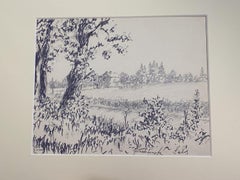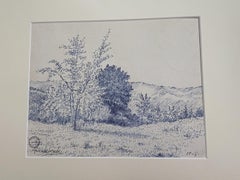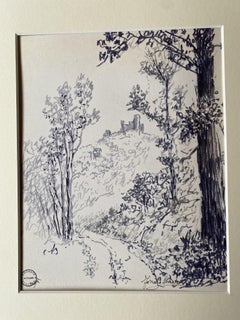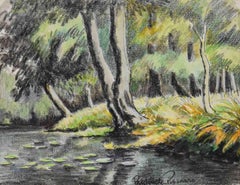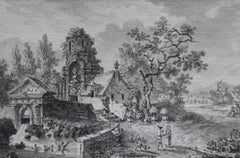Socrate Foscato Art
to
3
Overall Width
to
Overall Height
to
3
2
1
3
1
1
3
3
10,026
2,754
1,379
1,375
3
Artist: Socrate Foscato
Bush - Original Ink Drawing by Socrate Foscato - Late 20th Century
By Socrate Foscato
Located in Roma, IT
"Bush" is an original China Ink drawing on ivory-colorated cardboard by Socrate Foscato.
In excellent conditions: As good as new.
Printing of Artteist's Atelier, on the lower left....
Category
Late 20th Century Socrate Foscato Art
Materials
Ink
Landscape - Original Ink Drawing by Socrate Foscato - 20th Century
By Socrate Foscato
Located in Roma, IT
"Landscape" is an original China Ink drawing on ivory-colorated cardboard by Socrate Foscato.
In very good conditions.
Hand-signed and printing of his atelier, on the lower left. ...
Category
20th Century Socrate Foscato Art
Materials
Ink
Landscape - Original Ink Drawing by Socrate Foscato - 20th Century
By Socrate Foscato
Located in Roma, IT
Landscape is an original china ink drawing on paper realized by Socrate Foscato.
Hand-signed, on the lower right. Cachet of the Artist's Atelier, on the lower left.
Good conditions.
Category
20th Century Socrate Foscato Art
Materials
Ink
Related Items
L'Ile des Oiseaux by Paulémile Pissarro - Landscape watercolour
By Paul Emile Pissarro
Located in London, GB
L'Ile des Oiseaux by Paulémile Pissarro (1884-1972)
Watercolour and charcoal on paper
23 x 31 cm (9 x 12 ¹/₄ inches)
Signed lower right, Paulémile Pissarro
Provenance
Private collec...
Category
20th Century Post-Impressionist Socrate Foscato Art
Materials
Paper, Ink, Watercolor
$4,800
H 9.06 in W 12.21 in
Louis Lesueur (1746-1803) Landscape with ruins, 1789, drawing signed and dated
Located in Paris, FR
Louis Lesueur (1746-1803)
A Fantasy Landscape with ancient ruins, 1789,
signed and dated "L Lesueur 1789" in the bottom centre
Pen and ink and ink wash on paper
14.8 x 22 cm
In goo...
Category
1780s Old Masters Socrate Foscato Art
Materials
Ink
$1,712
H 5.83 in W 8.67 in
Glastonbury Abbey
By Frederick Nash
Located in Middletown, NY
Ink wash with watercolor in sepia and black, and blue, on buff wove watercolor paper, 14 1/4 x 10 1/4 inches (360 x 260 mm). 1/4" of the lower right corner is lost, minor crack (doe...
Category
Mid-19th Century English School Socrate Foscato Art
Materials
Ink, Watercolor, Handmade Paper
Solo Race in a Catamaran - Adventure Illustration in Watercolor and Ink on Paper
Located in Soquel, CA
Detailed illustration of a sailor in a catamaran by Edward T. Liljenwall (American, 1943-2010). The sailboat is tilted at an extreme angle, with the sailor leaning out over the edge ...
Category
1980s Pop Art Socrate Foscato Art
Materials
Ink, Color Pencil, Laid Paper
$1,720 Sale Price
20% Off
H 21.25 in W 14 in D 0.03 in
"Persepective", Pigments Watercolor Acrylic Paper Drawing
By Frank Girard
Located in Clermont-Ferrand, Auvergne-Rhône-Alpes
Titled "Perspective", this artwork created by Frank Girard, utilizes pigments, Chinese ink, watercolors, acrylics, and colored pencils on 400g/m2 neutral white paper. It remains unfr...
Category
2010s Realist Socrate Foscato Art
Materials
Paper, Ink, Acrylic, Watercolor, Color Pencil, Pigment
$838 Sale Price
20% Off
H 13.39 in W 17.33 in D 0.02 in
Whimsical Illustration "Snow" Cartoon, 1938 Mt Tremblant Ski Lodge William Steig
By William Steig (b.1907)
Located in Surfside, FL
Lighthearted Illustration of Outdoor Pursuits This one being cross country Snow Shoes signed "W. Steig"
Provenance: from Mrs. Joseph B. Ryan, Commissioned by ...
Category
1930s American Modern Socrate Foscato Art
Materials
India Ink, Watercolor, Illustration Board
Whimsical Illustration Hiking Cartoon, 1938 Mt Tremblant Ski Lodge William Steig
By William Steig (b.1907)
Located in Surfside, FL
Lighthearted Illustration of Outdoor Pursuits This one being cross country hiking signed "W. Steig"
Provenance: from Mrs. Joseph B. Ryan, Commissioned by Joe Ryan for the bar at his ski resort, Mount Tremblant Lodge, in 1938.
Mont Tremblant, P.Q., Canada
Watercolor and ink on illustration board, sights sizes 8 1/2 x 16 1/2 in., framed.
In 1938 Joe Ryan, described as a millionaire from Philadelphia, bushwhacked his way to the summit of Mont Tremblant and was inspired to create a world class ski resort at the site. In 1939 he opened the Mont Tremblant Lodge, which remains part of the Pedestrian Village today. This original illustration is on Whatman Illustration board. the board measures 14 X 22 inches. label from McClees Galleries, Philadelphia, on the frame backing paper.
William Steig, 1907 – 2003 was an American cartoonist, sculptor, and, in his later life, an illustrator and writer of children's books. Best known for the picture books Sylvester and the Magic Pebble, Abel's Island, and Doctor De Soto, he was also the creator of Shrek!, which inspired the film series of the same name. He was the U.S. nominee for both of the biennial, international Hans Christian Andersen Awards, as a children's book illustrator in 1982 and a writer in 1988.
Steig was born in Brooklyn, New York in 1907, and grew up in the Bronx. His parents were Polish-Jewish immigrants from Austria, both socialists. His father, Joseph Steig, was a house painter, and his mother, Laura Ebel Steig, was a seamstress who encouraged his artistic leanings. As a child, he dabbled in painting and was an avid reader of literature. Among other works, he was said to have been especially fascinated by Pinocchio.He graduated from Townsend Harris High School at 15 but never completed college, though he attended three, spending two years at City College of New York, three years at the National Academy of Design and a mere five days at the Yale School of Fine Arts before dropping out of each.
Hailed as the "King of Cartoons" Steig began drawing illustrations and cartoons for The New Yorker in 1930, producing more than 2,600 drawings and 117 covers for the magazine. Steig, later, when he was 61, began writing children's books. In 1968, he wrote his first children's book. He excelled here as well, and his third book, Sylvester and the Magic Pebble (1969), won the Caldecott Medal. He went on to write more than 30 children's books, including the Doctor DeSoto series, and he continued to write into his nineties. Among his other well-known works, the picture book Shrek! (1990) formed the basis for the DreamWorks Animation film Shrek (2001). After the release of Shrek 2 in 2004, Steig became the first sole-creator of an animated movie franchise that went on to generate over $1 billion from theatrical and ancillary markets after only one sequel. Along with Maurice Sendak, Saul Steinberg, Ludwig Bemelmans and Laurent de Brunhofff his is one of those rare cartoonist whose works form part of our collective cultural heritage.
In 1984, Steig's film adaptation of Doctor DeSoto directed by Michael Sporn was nominated for the Academy Award for Best Animated Short Film. As one of the most admired cartoonists of all time, Steig spent seven decades drawing for the New Yorker magazine. He touched generations of readers with his tongue–in–cheek pen–and–ink drawings, which often expressed states of mind like shame, embarrassment or anger. Later in life, Steig turned to children's books, working as both a writer and illustrator.
Steig's children's books were also wildly popular because of the crazy, complicated language he used—words like lunatic, palsied, sequestration, and cleave. Kids love the sound of those words even if they do not quite understand the meaning. Steig's descriptions were also clever. He once described a beached whale as "breaded with sand."
Throughout the course of his career, Steig compiled his cartoons and drawings into books. Some of them were published first in the New Yorker. Others were deemed too dark to be printed there. Most of these collections centered on the cold, dark psychoanalytical truth about relationships. They featured husbands and wives fighting and parents snapping at their kids. His first adult book, Man About Town, was published in 1932, followed by About People, published in 1939, which focused on social outsiders. Sick of Each Other, published in 2000, included a drawing depicting a wife holding her husband at gunpoint, saying, "Say you adore me."
According to the Los Angeles Times, fellow New Yorker artist Edward Sorel...
Category
1930s Naturalistic Socrate Foscato Art
Materials
Archival Ink, Watercolor, Illustration Board
Cottages in Devon
By Samuel Prout
Located in Middletown, NY
An early Devonshire landscape, ex-collection West Collection of British Watercolors & the Fine Art Society, London.
Circa 1800
Ink and brown wash on paper, 7 1/8 x 10 1/4 inches (...
Category
Early 1800s Realist Socrate Foscato Art
Materials
Ink, Watercolor, Graphite
"The Cold Wind in the Pine Trees", Pigments Watercolor Acrylic Paper Drawing
By Frank Girard
Located in Clermont-Ferrand, Auvergne-Rhône-Alpes
Titled "The cold wind in the pine trees", this artwork created by Frank Girard, utilizes pigments, Chinese ink, watercolors, acrylics, and colored pencils on 400g/m2 neutral white pa...
Category
2010s Realist Socrate Foscato Art
Materials
Paper, Ink, Acrylic, Watercolor, Color Pencil, Pigment
$838 Sale Price
20% Off
H 13.39 in W 17.33 in D 0.02 in
Tenterden by Lucien Pissarro - Watercolour
By Lucien Pissarro
Located in London, GB
Tenterden by Lucien Pissarro (1863-1944)
Watercolour, ink, pen and coloured crayon
16.5 x 24 cm (6 ¹/₂ x 9 ¹/₂ inches)
Signed with monogram and titled lower right
Provenance: The Redfern Gallery...
Category
20th Century Post-Impressionist Socrate Foscato Art
Materials
Crayon, Ink, Watercolor, Pen
Village in Normandy, Watercolour on Paper by Paulémile Pissarro, 1920
Located in London, GB
Village in Normandy by Paulémile Pissarro (1884 - 1972)
Watercolour, ink and charcoal on paper
40 x 31.2 cm (15 ³/₄ x 12 ¹/₄ inches)
Signed lower left, Paulémile Pissarro
Executed ...
Category
1920s Post-Impressionist Socrate Foscato Art
Materials
Watercolor, Charcoal, Ink
$3,600
H 15.75 in W 12.29 in
"Literary Garden, " Chinese Scroll Painting
Located in Chicago, IL
Exquisitely painted with delicate line work and a subdued color palette, this Chinese scroll painting is an early 20th century reproduction of a famous...
Category
Early 20th Century Qing Socrate Foscato Art
Materials
Silk, Paper, Ink
Socrate Foscato art for sale on 1stDibs.
Find a wide variety of authentic Socrate Foscato art available for sale on 1stDibs. You can also browse by medium to find art by Socrate Foscato in ink and more. Not every interior allows for large Socrate Foscato art, so small editions measuring 8 inches across are available. Socrate Foscato art prices can differ depending upon medium, time period and other attributes. On 1stDibs, the price for these items starts at $251 and tops out at $334, while the average work can sell for $312.
